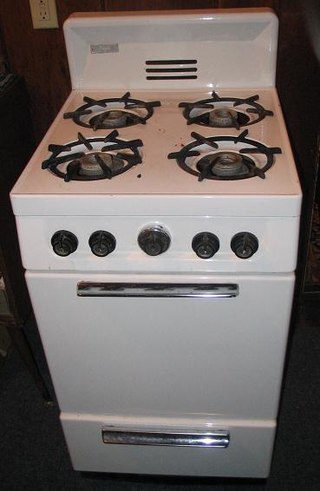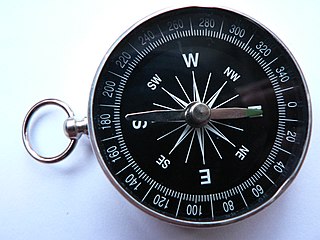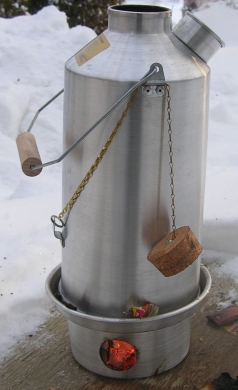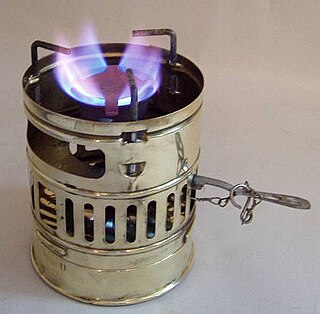
A wok is a deep round-bottomed cooking pan from China. It is common in China and similar pans are found in parts of East, South and Southeast Asia, as well as being popular in other parts of the world.

Camping is a form of outdoor recreation involving overnight stays with a basic temporary shelter such as a tent. Camping can also include a recreational vehicle, a permanent tent, a shelter such as a bivy or tarp, or no shelter at all. Typically, participants leave developed areas to spend time outdoors, in pursuit of activities providing them enjoyment or an educational experience. Spending the night away from home distinguishes camping from day-tripping, picnicking, and other outdoor activities.

A portable stove is a cooking stove specially designed to be portable and lightweight, used in camping, picnicking, backpacking, or other use in remote locations where an easily transportable means of cooking or heating is needed. Portable stoves can be used in diverse situations, such as for outdoor food service and catering and in field hospitals.

Outdoor cooking is the preparation of food in the outdoors. A significant body of techniques and specialized equipment exists for it, traditionally associated with nomadic cultures such as the Berbers of North Africa, the Arab Bedouins, the Plains Indians, pioneers in North America, and indigenous tribes in South America. These methods have been refined in modern times for use during recreational outdoors pursuits, by campers and backpackers.

Backpacking is the outdoor recreation of carrying gear on one's back, while hiking for more than a day. It is often an extended journey, and may involve camping outdoors. In North America tenting is common, where simple shelters and mountain huts, widely found in Europe, are rare. In New Zealand, hiking is called tramping and tents are used alongside a nationwide network of huts. Hill walking is an equivalent in Britain, though backpackers make use of a variety of accommodation, in addition to camping. Backpackers use simple huts in South Africa. Trekking and bushwalking are other words used to describe such multi-day trips.

A beverage-can stove, or pop-can stove, is a do it yourself, ultralight, alcohol-burning portable stove. It is made using parts from two aluminium beverage cans. Basic designs can be relatively simple, but many variations exist.

A mess kit is a collection of silverware and cookware used during camping and backpacking, as well as by military personnel for food and military rations. There are many varieties of mess kits available to consumers, and militaries commonly issue them to their personnel.

Induction cooking is performed on an electric stove using direct induction heating of cooking vessels, rather than relying on indirect radiation, convection, or thermal conduction. Induction cooking allows high power and very rapid increases in temperature to be achieved: changes in heat settings are instantaneous.

A gas stove is a stove that is fuelled by combustible gas such as syngas, natural gas, propane, butane, liquefied petroleum gas or other flammable gas. Before the advent of gas, cooking stoves relied on solid fuels such as coal or wood. The first gas stoves were developed in the 1820s and a gas stove factory was established in England in 1836. This new cooking technology had the advantage of being easily adjustable and could be turned off when not in use. The gas stove, however, did not become a commercial success until the 1880s, by which time supplies of piped gas were available in cities and large towns in Britain. The stoves became widespread on the European Continent and in the United States in the early 20th century.

Trangia is a line of alcohol-burning portable stoves manufactured by Swedish company Trangia AB in Trångsviken. These stoves are designed primarily for backpackers, with a focus on light weight, durability and simple design. The company began in 1925, selling cookware. The Trangia stove was developed by 1951. Trangia stoves were initially preferred to kerosene (paraffin) pressure stoves because they required only one type of fuel. Trangia's selling point is that the entire packaged stove, including pots, is not significantly larger than a standard camp cooking pot. For this reason the Trangia has retained much of its popularity despite the development of alternative stove fuels and designs.

The Ten Essentials are survival items that hiking and Scouting organizations recommend for safe travel in the backcountry.

Kelly Kettle, Storm Kettle, Ghillie Kettle, Thermette, Survival Kettle and Volcano Kettle are trade names for portable devices for boiling water outdoors using twigs and other small combustible materials; these devices consist of a water jacket surrounding a fire chamber which creates an upward chimney draft ensuring efficient and rapid boiling even in windy or wet weather.

Ultralight backpacking is a subset of lightweight backpacking, a style of backpacking which emphasizes carrying the lightest and least amount of gear. While no technical standards exist, some hikers consider "ultralight" to mean an initial base weight of less than 4.5 kg (9.9 lb). Base weight is the weight of a fully loaded backpack at the start of a trip, excluding worn weight and consumables such as food, water, and fuel. Base weight can be lowered by reducing the weight of individual items of gear, or by choosing not to carry that gear. Ultralight backpacking is most popular among thru-hikers.
Hiking equipment is the equipment taken on outdoor walking trips. Hiking is usually divided into day-hikes and multiple-day hikes, called backpacking, trekking, and walking tours.

Backpacker is an American lifestyle magazine publication that features information on wilderness hiking and adventure. It has been published since 1973. Backpacker magazine is currently published by Outside and is based in Boulder, Colorado.

The Svea 123 is a small liquid-fuel pressurized-burner camping stove that traces its origins to designs first pioneered in the late 19th century. Although it was originally made in Sweden it is now built in Taiwan by Optimus.

Camping food is food brought on or designed for camping, hiking, and backpacking trips. The term also encompasses ingredients that can be used to make said foods. The primary differences relate to campers' and backpackers' special needs for foods that have appropriate cooking time, perishability, weight, and nutritional content. To address these needs, camping food is often made up of freeze-dried, dehydrated, precooked, pre-prepared, or otherwise preserved foods that can last extended periods of time.

The G.I. pocket stove is a World War II–era portable pressurized-burner liquid-fuel stove designed by the Coleman Company of Wichita, Kansas and manufactured by both the Coleman Company and the American Gas Machine Company (AGM) of Albert Lea, Minnesota.
Primus AB is a manufacturer of portable cooking devices and outdoor stoves based in Stockholm, Sweden.



















